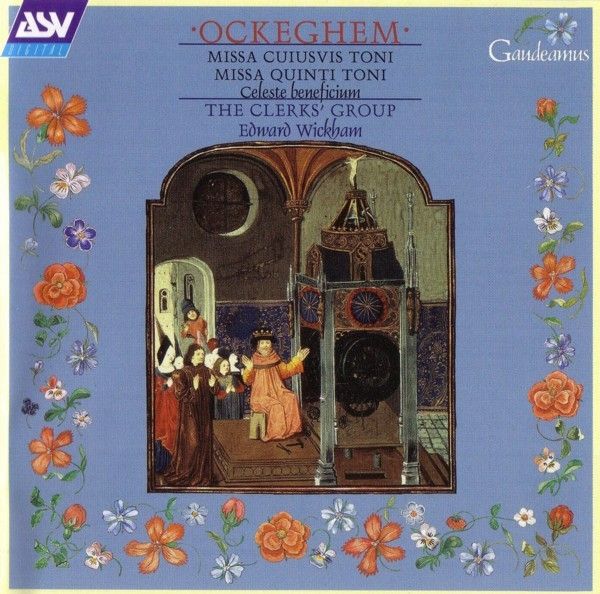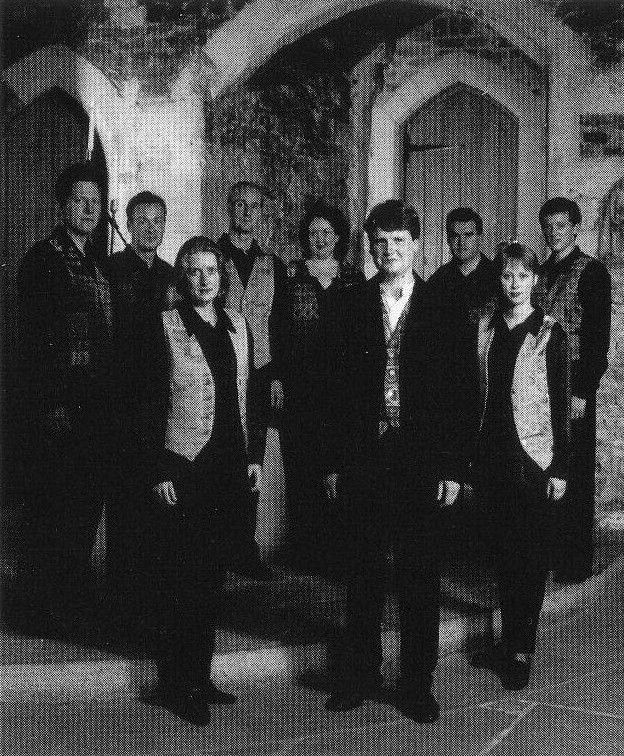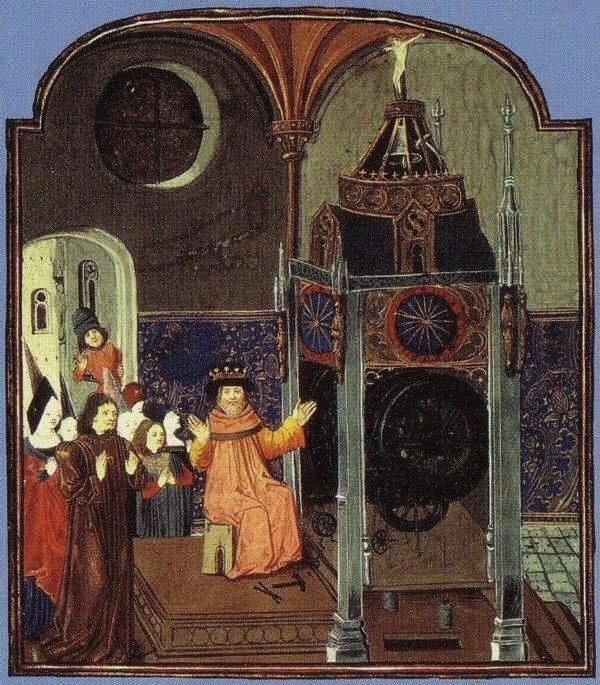Johannes OCKEGHEM. Missa Cuiusvis toni · Missa Quinti toni
Celeste beneficium (attr.) / The Clerks' Group

medieval.org
AS&V "Gaudeamus" CD GAU 189
1999
Johannes OCKEGHEM
(c.1410-1497)
Missa Cuiusvis toni
1. Kyrie on fa-ut · Mixolydian mode [1:36]
2. Kyrie [1:47]
3. Gloria [4:14]
4. Credo on mi [7:15]
5. Santus and Benedictus on mi [5:44]
6. Agnus Dei [3:30]
on mi · Phrygian mode
7. Agnus Dei on fa-ut · Mixolydian mode [3:30]
8. Celeste beneficium [9:26]
(attr. to J. Ockeghem)
Missa Quinti toni
9. Kyrie [1:56]
10. Gloria [5:06]
11. Credo [7:27]
12. Sanctus and Benedictus [6:18]
13. Agnus Dei [6:21]
THE CLERKS' GROUP
Edward Wickham
sopranos: Carys Lane, Rebecca Outram
altos: Robin Blaze, William Missin
tenors: Stephen Harrold, James Gilchrist, Matthew Vine
basses: Jonathan Arnold, Robert Macdonald
Produced by Jonathan Freeman-Attwood
Recorded by Paul Proudman / ProudSound
Recorded in St. Andrew's Church, West Wratting, 6-7 February 1998, by
kind permission of the Vicar and P.C.C.
Designed by Studio B, The Creative People
Cover: Manuscript of the household admiring the master's rare clock,
from a treatise on morality, Flemish, mid 15th century
courtesy of
Bibliotheque Nationale, Paris, / Bridgeman Art Library, London/New York

The two Masses on this recording present different facets of Ockeghem's
art. Until recently, the composer's reputation as a cerebralist,
concerned primarily with devising musical puzzles, was based upon a
group of works that forms only a small part of his output: two canonic
pieces, the Mass Prolationum (recorded by The Clerks' Group,
ASV CD GAU 143), the song Prenez sur moy and the Mass Cuiusvis
toni. The precise meaning of the title of the latter is disputed:
it has been variously translated as “in any mode” or
“on any tone you wish”. The Mass is designed in such a way
that its musical notation admits of several possible realisations: if,
for example, the singers start on the note Re, the Mass will
sound in the Dorian mode; if on Mi it will sound in the
Phrygian, while the note Fa yields a Lydian version. Although
there was an undeniable speculative streak in Ockeghem's intellectual
make-up, it would be quite wrong to regard Cuiusvis toni as a
purely theoretical showpiece. In fact, it may have served an eminently
practical purpose. As head of the French royal chapel for more than 40
years (1454-1497), Ockeghem must have been responsible for the
recruitment of singers. Cuiusvis toni would have been an ideal
test-piece for prospective entrants, for whom the
“decoding” at sight of different sounding versions from the
one notation would have required considerable mental agility. Whatever
the circumstances of Cuiusvis toni's composition, Ockeghem
would have been amused to learn that certain aspects of his puzzle (for
instance, the precise number of realisations he intended) continue to
perplex musicians more than 500 years later.
All this explains the Cuiusvis toni's enduring fascination to
music theorists (certainly it is the only Mass by Ockeghem transmitted
in sixteenth-century prints as well as fifteenth-century manuscripts)
but the listener, too, cannot fail to be impressed — perhaps
surprised — by its uncomplicated directness in performance. In
the longer-texted Gloria and Credo, the word-setting is mostly
syllabic, resulting in very concise phrases and a predominantly chordal
texture that are rather unusual for Ockeghem. In the other movements,
the brevity of the text makes melismas (that is, the setting of single
syllables to more than one note) inevitable; yet even these are brief
by Ockeghem's standards. As a result, Cuiusvis toni is (by a
considerable margin) the shortest Mass yet recorded in this series. In
order to illustrate its different versions, The Clerks' Group presents
a performance of the Kyrie and Agnus Dei on Fa (giving a
“major-mode” flavour), and they sing the entire Mass in
what might be described as Ockeghem's “signature” mode of Mi,
the Phrygian, which
has no modern equivalent.
If Cuiusvis toni is one of its composer's most famous pieces,
the three-voice Quinti toni Mass is performed only rarely. But
as we have seen, Cuiusvis toni's notoriety is due not so much
to its aesthetic qualities as to its role in shaping the historical
perception of Ockeghem; conversely, Quinti toni owes its
neglect largely to long-held assumptions regarding three-voice Masses.
Music historians early in this century noticed that Mass-composition in
three voices gradually tailed off as the fifteenth century progressed,
replaced by the four-voice model. While this is broadly correct in
purely factual terms, there is nothing to suggest that
fifteenth-century musicians considered four voices a qualitative
“advance” on three. Nevertheless, modern critics came to
regard Ouinti toni as an early work, on the assumption that it
was written before the four-voices idiom came into vogue (or —
still more belittlingly — before the younger composer had
mastered it). More recently, it has come to be recognised that
different Mass genres flourished alongside each other throughout the
fifteenth century. Ironically, the prejudice that once worked against Ouinti
toni may now play in its favour: recent scholarship places its
composition in the 1470s, which would make the work a product of
Ockeghem's maturity. Very few of his works may be dated much later with
any confidence.
Another possible reason for Quinti toni's relative obscurity is
its prosaic title, which simply classifies it as being “in the
fifth [Lydian] mode”. There is nothing to signal the presence of
pre-existent material found in so many Masses of the time (including
most of Ockeghem's). But the fact that no model is named does not
entirely rule one out: a case in point is Ockeghem's Mi-mi Mass
(a much more intriguing title!), now widely believed to be based on his
song Presque trainsi. As with Mi-mi, the attentive
listener will discern ideas that recur in each of Quinti toni's
movements (especially in the middle voice). It is quite possible that
these motifs are so many echoes of a hidden model now lost to us.
So Quinti toni has neither technical tours de force to delight
the connoisseur, nor an enigmatic title to intrigue the student, nor
yet a known model to help the listener along. What it does contain is
some of Ockeghem's most beguiling inspirations. Where Cuiusvis toni
is concise and chordal, Quinti toni is luxuriantly expansive:
as with the finest chamber music, one often has the impression that
more voices are involved than there actually are. Each has its own
distinct range and engages the others in a constant play and exchange
of ideas, encompassing a variety of moods. At times, the music assumes
a quality of repose that is deeply affecting (for instance, in the
Credo at the words 'Deum de Deo'); but in the Hosanna there is almost
unrestrained exuberance, and the Amens that conclude the longer
movements are among the most expansive and exciting that Ockeghem ever
wrote. In a work like the Requiem (recorded by The Clerks'
Group on ASV CD GAU 168) we hear the composer's public voice,
ceremonial and rhetorical; with the gentle lyricism of Quinti toni
Mass we seem to glimpse a more intimate view; Ockeghem's style in its
quintessential expression.
The third work on this disc represents yet another facet of our
composer: the five-voice motet Celeste beneficium belongs to
the rather large group whose ascription to Ockeghem is disputed. While
its structure and melodic style make his authorship seem unlikely, it
says something for his reputation that ascriptions could still be made
to him 40 years after his death (assuming that the name
“Okegus” designates him). And if the music is by Ockeghem,
the surviving text (which includes an exhortation to the German nation,
Germania) cannot be original. The strategy of pairing voices against
each other (observed throughout the work) places this prolix and
extended piece in the following generation.
© Fabrice Fitch, 1999
Editions used for this recording:
Mass Cuiusvis toni, Johannes Ockeghem: Masses and Mass
Sections, ed. Jaap van Benthem (Utrecht; Koninklijke Vereniging voor
Nederlandse Muzickgechiedenis, 1997),iii, 1.
Mass Quinti toni: ed. Fabrice Fitch.
Editions used by permission.



